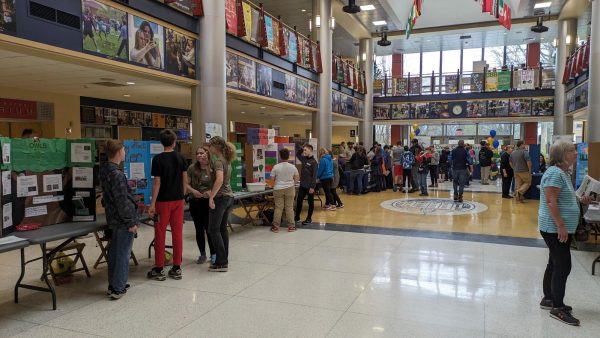ALIC allows for exploration of technical passions
The Allegheny Lab for Innovation and Creativity has been described by Byron Rich, associate professor of art and director of academic innovation partnerships, as a “maker’s space plus some.” The ALIC has spent much of its short life, only about two years, amidst the COVID-19 pandemic, but has nonetheless managed to become a place where students and faculty from all disciplines can come to learn, teach and create.
Rich helped spearhead the creation of the ALIC. He described how he and several other faculty members identified a need for a central learning and creation space. While many departments had their own labs and studios to investigate science and make art, the division of these spaces left something to be desired.
The concrete idea of the ALIC came up sometime in 2015. Soon after, Provost and Dean of the College Ron Cole, ’87, allowed funding to be allotted to the ALIC, and with the help of the Alden Trust Grant, the lab was created.
Other faculty members who helped lead the development of the ALIC include Janyl Jumadinova, Julie Wilson, River Branch, Michael Mehler, Jamie Lombardi, Heather Brand, Ian Thomas, Paula Burleigh and Amelia Carr. They span across disciplines like computer science, communication arts, history and art. This diversity of study speaks to how interdisciplinary the ALIC is meant to be.
The ALIC is made of two parts — a computer lab and a fabrication facility. These two parts include a wide variety of technology and software any student or professor can use. This includes a CNC machine, multiple 3-D printers, drones, laser cutters, video game development software, 3-D modelling software, video and photo editing software and more. Many professors, including assistant professor and department chair of computer science Janyl Jumadinova, have noted how having so much technology in one space that is open to people from every department has allowed for exciting mixing of disciplines, causing the ALIC to be a truly innovative space.
The ALIC is currently open for any student to use, for a class project, for a personal passion project or hobby or for any other reason they see fit. There are often technicians in the lab who can assist with some of the technology, however, classes have also been arranged where students can become introduced to the resources available in the ALIC.
Jumadinova has played a key role in the creation of the video game design and development courses, which have and will explore many facets of video game development, from the business side to sound design. Some other courses that have been created so far explore technology used in healthcare, software used in aerospace manufacturing, and local and creative ways of marketing. Not only do these courses introduce students to the technology in the ALIC, but because all of the technology in the ALIC is industry standard and many of these courses are taught by industry professionals, these courses are opportunities for students to connect to internships and even future jobs.
Students can also get involved with the ALIC through extracurriculars. Jumadinova is the advisor for the Robotics Club, and has worked extensively with students in the ALIC to create robots and experiment with AI. They have even organized a robotics community outreach event pre-COVID.
Michael Mehler, professor and department chair of communication, film, and theatre, described how students involved in the communication department have had opportunities to utilize the ALIC as well.
In the past, when faculty and students were building sets and needed to cut complicated curves or print repetitive designs, the ALIC’s technology was used. This allowed students to learn how to use technology highly relevant and valuable to technical theater. There continue to be upcoming opportunities for students in the communication department to use the ALIC, including in future set design.
Mehler also recalled his excitement at finally seeing the lab come to fruition.
“I remember when I first started here, in 2008 or 2009, and it was just a conversation,” Mehler said. “It’s nice to see it finally implemented.”
Jumadinova said that ALIC is the culmination of several years of planning across disciplines.
“ALIC is awesome,” Jumadinova said. “It’s been a dream of several years for several faculty that needed space for research and teaching outside of classrooms.”
Both professors also explained their joy at seeing students from so many different departments sharing ideas with one another, and their fascination with how so many different ideas interacted.
Faculty themselves are also able to freely use the ALIC for their own research and endeavors. Rich himself sometimes employs the ALIC to develop his art. Jumadinova uses the software in the computer lab to research and build artificial intelligence.
The ALIC has already proved to be an exciting resource, and there is still more progress to look forward to. There are plans to hopefully expand the space and technology available in the ALIC.Classes offered there will also continue, especially as more connections are made to local professionals that can lead courses.
Students who are interested in taking courses in the ALIC should watch MyAllegheny, where courses in the ALIC will be announced. Students and faculty alike can take time to explore the ALIC and see what it has to offer them.






